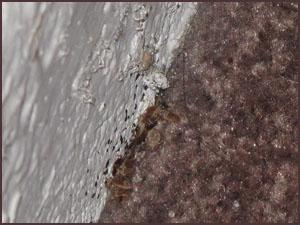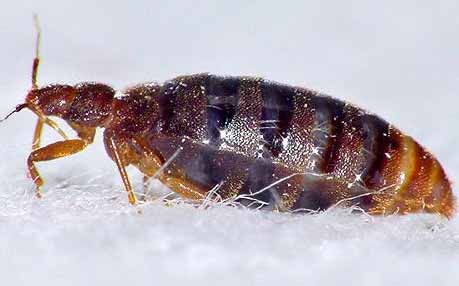EDITORS NOTE: Joe Shorthouse is an entomologist and a professor emeritus with Laurentian University. This article is the second in a series of two examining the Islands relationship with the bity critters with whom we share the land.
by Joe Shorthouse
After discussing mosquitoes, black flies, horse and deer flies in Part I (September 7, 2022), I continue here with fleas, bed bugs, lice and ticks. Ways to reduce being annoyed and fed upon by these blood-feeders is also discussed.
Fleas
Adult fleas are small, yellowish-brown to black, wingless insects about 3 mm in length specialized for life on furry or feathered animals feeding on blood to survive and reproduce. They are laterally flattened shaped like a coin standing on end.
Adult fleas have stiff backward-pointing hairs which makes it easy for them to move through their hairy hosts while making them difficult to dislodge by grooming. They have muscular legs, each with a pair of claws used to grasp hairs.
The immatures of fleas look like tiny caterpillars and do not feed on blood. Instead, they feed on faeces and organic material found in the beds of dogs and cats.
There are about 300 species of fleas feeding on birds and mammals in North America, with about 127 in Canada. Fleas traditionally do not bother people on Manitoulin Island, but anyone with a dog or cat knows they sometimes bite the owners.
Fleas cause major discomfort to cats and dogs and can lead to an eczematous itchy skin disease called flea allergy dermatitis. The bites often appear in clusters or lines of two and can remain itchy and inflamed for several weeks.
Newly formed adults can lay dormant in a hosts bed for up to a year, until a host animal is detected. They detect a potential host (sometimes a human) using cues such as low-frequency sound, vibration and increases in temperature and CO2 levels.
Adult fleas are effectively removed from the fur of pets using a fine-toothed flea comb, and are most easily spotted against a light background, such as a white sheet. Flea infestations are controlled by first eliminating adult fleas, and then by eliminating larvae and pupae.
A number of products are available at pet stores for treating adult fleas both on pets and in the home. Immature stages can be removed by washing pet bedding, vacuuming or steam-cleaning carpets and furniture, and by carefully cleaning floors and baseboards where pets sleep.
Being blood feeders makes fleas potential transmitters of diseases such as bubonic plague where they transmit a bacterium from rodents to humans. There are no diseases caused by fleas on Manitoulin Island.
Bed bugs
Adult bed bugs are small, reddish brown, flattened and oval, wingless insects about the size of an apple seed (5-7 mm in length) which makes it easy for them to hide in tiny crevices.
They have been a pest throughout human history causing itchy bites and irritation. They were so common in the past, people accepted them as a part of their lives, reflected in the popular saying Good night. Sleep tight. Dont let the bed bugs bite.
Bed bugs creep us out because they crawl over our bodies while we are sleeping, suck our blood, then take refuge in folds of mattresses, carpets, under baseboards, and wallpaper.
They feed only at night by piercing the skin with two hollow tubes and injecting saliva with anticoagulants in one, then sucking up blood through the other. In most cases, victims of these tiny vampires are unaware that they are donating blood because of anesthetics in the saliva. Each feeding takes 3-12 minutes.
Bed bugs have five progressively larger nymphal stages, each requiring at least one blood meal before moulting to the next stage. The entire life cycle from egg to adult requires five weeks to four months, depending on temperature and availability of blood meals.
Both males and females feed on blood. Each female can produce hundreds of eggs in her lifetime, but when blood is unavailable, they can remain dormant for months. They have the uncanny ability to detect our bodies from a distance and can walk along the ceiling then accurately drop onto our beds and join us under the covers.
We have come to associate the presence of bed bugs with a lack of cleanliness; however, they frequently show up in immaculate homes. Bed bugs dont care if their environment is clean or dirty; all they need is a warm host and plenty of hiding places.
Unfortunately, bed bugs have become increasingly common since the 1990s. Their resurgence is likely due to increased global travel and commerce, ease of movement of infested items, resistance to pesticides, and changes in pesticides available for their control.
The Sudbury and District Health Unit does not keep records of bed bug findings on Manitoulin Island, but there is always the potential for infestations. Learn to recognize signs of their presence such as rusty stains on bed sheets or mattresses caused by bed bugs being crushed, dark spots which are excrement, or live bed bugs.
Bites on the skin are an unreliable indicator of an infestation because bed bug bites look like bites from other insects (such as mosquito), rashes (such as eczema or fungal infections), or even hives. Victims of bedbugs usually wake up to a distinctive row of three bite marks.
Bed bugs rely on humans to move them from one building to another. Bed bugs were likely first brought to all the islands in the Great Lakes in the canoes of early explorers.
Bed bugs are exceptional hitchhikers, travelling on clothing, bedding, luggage, furniture and cardboard boxes. As a result, they can be found in hotels, cruise ships, airplanes, trains and buses. Always check old mattresses and furniture for bed bugs before bringing them into your home.
If found in your home, find a reputable pest control company to treat the infestation early with insecticides before it becomes established or spreads. Steaming, vacuuming and applying insecticides to mattresses, pillows and beds eliminates bed bugs. Placing your luggage in plastic bags when in hotel rooms suspected of having bed bugs prevents transporting them home.
Bed bugs do not carry or transmit diseases. They are not a dangerous medical threat; however, the discovery of bedbugs in homes or hotel rooms results in considerable stress.
Lice
Lice are tiny insects about 1mm in length, oval, and usually yellow to white and sometimes with a red belly. They have fed on us throughout human history. The phrases you nit picker or I am feeling lousy reflect the human disdain for these insects.
Two kinds of lice are found on humans head (or body lice) and pubic lice. Head lice are commonly called cooties whereas pubic lice are called crabs. Both kinds spend their entire life cycle on humans. They cannot live off our bodies for more than 24 hours and are never found on pet dogs and cats.
Lice spread between people by crawling from the hair of one infested person to another. Adult head lice can live for 30 days on a persons head and lay 150 250 eggs during its life cycle.
Eggs of head lice are called nits and are glued to the base of hairs near the scalp. They take about one week to hatch. Nymphs become adults about 7 10 days after hatching.
Pubic lice attach themselves to coarse hairs in the pubic region, eyebrows, eyelashes, beards and armpits. They are sometimes charmingly described by the phrase papillons damour or butterfly of love (no further explanation needed in a family newspaper).
Lice take blood meals about six times a day. They inject saliva at each feeding which causes inflammation leading to intense itching. Itching leads to scratching and secondary bacterial infections. An itching scalp is the chief symptom, whereas presence of viable nits confirms the diagnosis.
Head lice infestations, or pediculosis, commonly occur among young children on Manitoulin Island during the winter. They spread from infected children when coats and hats are piled together or sharing bike helmets, brushes and head phones.
Lice were likely common among all the early peoples of Manitoulin Island, both Indigenous and settler peoples.
Head lice are not a significant health hazard nor an indication of poor hygiene. However, several infectious diseases such as epidemic typhus, relapsing fever, and trench fever can occur when people live in poor-hygiene caused by war, social disruption, or severe poverty. No diseases associated with lice are found on Manitoulin Island.
Head lice are detested especially among children and their presence usually results in fear and frenzied attempts to get rid of them. When active lice or nits are detected, it is important not to panic as they are easy to eliminate by using shampoos containing the insecticide pyrethrin, readily available at pharmacies. Ivermectin lotion such as Sklice is a topical, single-dose treatment applied directly to the scalp for 10 minutes and then rinsed with water.
If lice are detected, wash all clothing, bedding, hats, stuffed animals, and towels with hot, soapy water at 50C and dry them at high heat for at least 20 minutes. Wash combs and brushes and soak them in rubbing alcohol for an hour.
Ticks
Ticks are not insects as they have four pairs of legs and two body parts. However, they have life cycles similar to insects whereby they start off at the egg stage, followed by nymphal stages, and then the adults. Nymphs look like small adults.
Common ticks in Canada include the blacklegged tick, more commonly known as the deer tick, the brown dog tick, and the American dog tick.
Unfed adult female blacklegged ticks are spider-shaped, approximately 3 to 5 mm in length and red or dark brown. Adult blacklegged ticks are smaller than the more common American dog tick.
Ticks cannot fly or jump and instead move about by climbing onto low vegetation and clinging onto passing mammals such as deer, dogs or people. Once ticks grasp hairs, they walk about on the skin then cut a hole and sink in their mouthparts. They attach a harpoon-like barbed structure near their mouthparts while injecting anticoagulant.
The average life span of an adult tick ranges from one to three years. They typically take a blood meal at each stage of the life cycle and when full grown can consume 100 times their weight in blood and become swollen. After engorging on the blood, they fall off and find shelter somewhere until they need to take another meal, then the process starts again.
Peak tick season for nymphs occurs during the spring and summer months, while adults are a threat in the late fall. They are usually found in wooded areas and areas overgrown with tall grasses.
When walking through areas of tall grass inhabited with ticks, wear light coloured clothing that makes it easier to spot ticks. Wear long-sleeve shirts and tuck your pant legs into long socks. Spray the lower parts of your pants, socks and shirt sleeves with insect repellent.
Do a full-body check before re-entering your home to ensure no ticks have attached to your clothing or pets. Examine your body when you shower or bath paying attention to arm pits, crotch and the site of bra straps.
Ticks are important vectors of Lyme disease. Early symptoms of Lyme disease include fatigue, fever, headaches, and rashes. One sign of the onset of Lyme disease is a bulls eye rash around the feeding site; however, not all people fed upon by a tick show the rash.
If a feeding tick is found and its mouthparts are sunk into your flesh, it must be removed with a pair of forceps (tweezers). Place the forceps on either side of the head region of the tick and gently pull without leaving any parts within your skin. Wash the area with soap and water.
Ticks on Manitoulin Island have tested positive for Lyme disease. Reporter Lori Thompson wrote about ticks and Lyme disease in the June 17, 2020 issue of The Manitoulin Expositor. This disease is caused by a bacteria spread by the bites of infected blacklegged ticks. A visit to a doctor to receive a dose of antibiotics is usually enough to treat the early stages of Lyme disease.
How to Avoid Blood Feeders
An exhibition at the Royal Ontario Museum in 2019 entitled Bloodsuckers: Leeches to Legends informed us that 30,000 species of animals around the world feed on blood. The show drew on science, medicine, popular culture and the supernatural to provide a refreshing perspective on the animals we have come to hate and fear.
People have been bothered by blood-feeding insects throughout history, and in many cases, we have learned to live with them. Mosquitoes and black flies, for example, are an irritating but inescapable part of the Canadian experience.
Mosquitoes were just one of the ROM stars in a much larger cast of squirm-inducing creatures that are united in their quest for the liquid lunch that flows through our veins.
At one time, our effort to eliminate many pest insects was centred on the insecticide DDT. At first it killed vast numbers of insects, but in time it bioaccumulated in the tissues of animals, including humans and birds resulting in an environmental disaster. No pests were eliminated by DDT while some became resistant and their numbers increased.
We also must recognize that larvae and adults of mosquitoes and black flies serve as food for the immatures of our sport fish. Males of mosquitoes and black flies are pollinators. Many species of birds and frogs eat adult blood feeders, so eliminating blood feeders would eliminate many fish, birds and frogs.
While the prospect of Manitoulin becoming free of blood-feeding insects is seductively attractive, past history has shown that attempts to exterminate has proven harmful and we instead should learn to avoid them.
It helps to understand their biology and avoid being in places when and where they are most abundant. Wear long-sleeved shirts, long pants and a hat when outdoors in biting fly season. Tuck your pants into your socks helps keep biting flies and ticks from getting under your clothing. Mosquitoes are attracted to dark moving objects so wear white, tan or yellow clothing.
Netting that covers the head, like the bonnets used by beekeepers, provides protection when biting flies are at their peak. Avoid wearing sweet-smelling perfumes and deodorants, or clothing tainted by fabric softeners. Dont eat candy or consume soft drinks when outdoors as their odours attract black flies.
Mosquito pics or coils help keep mosquitoes from coming indoors. Pics are a repelling incense made with pyrethrum powder which is a natural insect repellent. Pics can burn for up to 5 hours and like candles, should never be left unattended.
The best way to avoid biting flies and ticks is to apply repellents with a high percentage of DEET (Diethyl-meta-toluamide) to exposed body surfaces. Spray it on your hat, arms, pant legs, socks, and exposed skin. Never spray repellents directly on your face and spray in well-ventilated areas away from food.
Always read the recommended levels before applying repellents on yourself and children. Safe and effective repellents are sold in most pharmacies, grocers, and outdoor stores in Canada. Sunscreen and insect repellent can be applied at the same time.
It is unfortunate that TV advertisements tell us that a chemical barrier must be laid down to prevent any creepy-crawlies from entering our homes and gardens, without mentioning the harm many such chemicals cause to human health and pets. As a result, many home owners regard all insects that enter their household with contempt which is both unfortunate and harmful.
Follow this link:
Manitoulin Blood Feeders: Part II of a series - Fleas, bed bugs, lice and ticks... oh my! - Manitoulin Expositor

 Residence
Residence  Location
Location 
 The transmission of bed bug eggs is also an issue. It is not uncommon for the live bed bugs amongst an infestation to be completely eradicated during an effective treatment cycle only to have the remaining or surviving eggs hatch and re infest the location. The bed bug eggs themselves are usually unaffected by and/or not killed by most approved pesticides. The eggs can also have an incubation period of up to several weeks and may be deposited in hidden areas that are difficult to penetrate, difficult to find, or simply hidden away from what otherwise would have been a quick lethal treatment (i.e., lethal treatment such as the killing of a bed bug's eggs through heat'”by hot ironing fabric surfaces where bed bugs have hidden, through steaming [typically using a fabric steamer], via direct machine drying, or through a procedural use of boiling water, etc.). This stubborn tendency of bed bug infestations towards reemergence can be incredibly problematic and all the more difficult to detect, due to the now smaller size of the newly re-emerged bed bug nymphs and their propensity for hiding in small, hard-to-find locations. Re infestation can be more difficult to discover early enough due to a corresponding decrease in the 'size' of infestation symptoms, such as fewer and now much smaller fecal droppings (resembling pinhead-sized dabs from a black permanent marker) which may be scattered and difficult to detect. There may be other evidence of re infestation, like sloughed-off skins which are tinier in size. Really, though there are only two types of synergy - to find out what they are, watch the video:
The transmission of bed bug eggs is also an issue. It is not uncommon for the live bed bugs amongst an infestation to be completely eradicated during an effective treatment cycle only to have the remaining or surviving eggs hatch and re infest the location. The bed bug eggs themselves are usually unaffected by and/or not killed by most approved pesticides. The eggs can also have an incubation period of up to several weeks and may be deposited in hidden areas that are difficult to penetrate, difficult to find, or simply hidden away from what otherwise would have been a quick lethal treatment (i.e., lethal treatment such as the killing of a bed bug's eggs through heat'”by hot ironing fabric surfaces where bed bugs have hidden, through steaming [typically using a fabric steamer], via direct machine drying, or through a procedural use of boiling water, etc.). This stubborn tendency of bed bug infestations towards reemergence can be incredibly problematic and all the more difficult to detect, due to the now smaller size of the newly re-emerged bed bug nymphs and their propensity for hiding in small, hard-to-find locations. Re infestation can be more difficult to discover early enough due to a corresponding decrease in the 'size' of infestation symptoms, such as fewer and now much smaller fecal droppings (resembling pinhead-sized dabs from a black permanent marker) which may be scattered and difficult to detect. There may be other evidence of re infestation, like sloughed-off skins which are tinier in size. Really, though there are only two types of synergy - to find out what they are, watch the video: 
 Encasing mattress and box springs in impermeable bed-bug-bite-proof encasements after a treatment for an infestation is an alternative treatment which works better and is more comfortable whereas wrapping bedding in plastic causes sweating.
Encasing mattress and box springs in impermeable bed-bug-bite-proof encasements after a treatment for an infestation is an alternative treatment which works better and is more comfortable whereas wrapping bedding in plastic causes sweating.
 Bed bugs cannot fly, they have been observed climbing a higher surface in order to then fall to a lower one, such as climbing a wall in order to fall onto a bed. The technique can also be used to help prevent bed bugs from crawling up along walls where warranted. Long strips of this taping method (i.e. curled duct tape over painter's tape) can be used on standard floors to cordon off, surround, and isolate infested furniture, to protect clean furniture, or as part of a treatment effort to help prevent bed bugs from crawling toward specific areas. Other common places to find bed bugs include: along and under the edge of wall-to-wall carpeting (especially behind beds and furniture).
Bed bugs cannot fly, they have been observed climbing a higher surface in order to then fall to a lower one, such as climbing a wall in order to fall onto a bed. The technique can also be used to help prevent bed bugs from crawling up along walls where warranted. Long strips of this taping method (i.e. curled duct tape over painter's tape) can be used on standard floors to cordon off, surround, and isolate infested furniture, to protect clean furniture, or as part of a treatment effort to help prevent bed bugs from crawling toward specific areas. Other common places to find bed bugs include: along and under the edge of wall-to-wall carpeting (especially behind beds and furniture).  Bed bugs like to hide in the cracks and electical outlets in walls, behind wallpaper, base boards and picture frames, between beds and around the creases of mattresses and in bedding materials. They have a rather pungent odor which is caused by an oil-like liquid they emit. Bed bugs are often carried into houses by clothes, luggage, furniture, and bedding. Or sometimes even by humans. Many household pests can be controlled or prevented by a simple insecticide bug spray on baseboards and exterior surfaces of the home. This is not the case when dealing with an infestation of bed bugs.
Bed bugs like to hide in the cracks and electical outlets in walls, behind wallpaper, base boards and picture frames, between beds and around the creases of mattresses and in bedding materials. They have a rather pungent odor which is caused by an oil-like liquid they emit. Bed bugs are often carried into houses by clothes, luggage, furniture, and bedding. Or sometimes even by humans. Many household pests can be controlled or prevented by a simple insecticide bug spray on baseboards and exterior surfaces of the home. This is not the case when dealing with an infestation of bed bugs. Bed bugs only search for blood donors when they are actually hungry. In the intervals between meals they spend their time in suitable hiding places in the vicinity of the bed. These may be crevices in the timber, joints in the bed, behind the headboard, beneath loose carpeting, behind pictures, behind wallpaper, in plug sockets, light switches, etc. When hungry, bed bugs come out from their retreat and start to search. Their senses are not capable of guiding them to a distant blood donor, but at distances of 5 - 10cm they will be attracted by the body warmth of the victim. Bed bugs can crawl up a wall and can also walk upside down on rough ceilings, but if they are not skilled they often fall down. This is the basis of stories that bed bugs, having observed that their victim had placed the legs of the bed in dishes of water, crawled up the wall and across the ceiling and let themselves fall on to the poor sleeping body. However the bed bug is not as crafty as this.
Bed bugs only search for blood donors when they are actually hungry. In the intervals between meals they spend their time in suitable hiding places in the vicinity of the bed. These may be crevices in the timber, joints in the bed, behind the headboard, beneath loose carpeting, behind pictures, behind wallpaper, in plug sockets, light switches, etc. When hungry, bed bugs come out from their retreat and start to search. Their senses are not capable of guiding them to a distant blood donor, but at distances of 5 - 10cm they will be attracted by the body warmth of the victim. Bed bugs can crawl up a wall and can also walk upside down on rough ceilings, but if they are not skilled they often fall down. This is the basis of stories that bed bugs, having observed that their victim had placed the legs of the bed in dishes of water, crawled up the wall and across the ceiling and let themselves fall on to the poor sleeping body. However the bed bug is not as crafty as this. 









